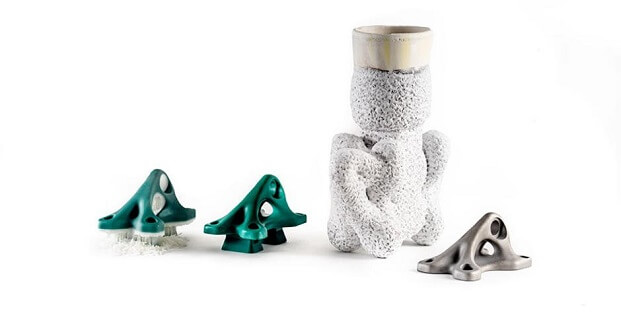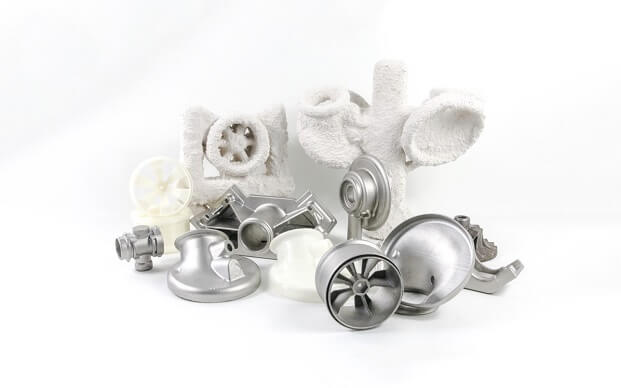Handbook: 3D Printing Investment Casting

Investment casting is an age-old manufacturing process, also known as precision casting or lost wax casting. The process involves using wax patterns covered with a ceramic slurry to design molds with the shape and form of the desired final piece. The wax is then heated to melt it out of the shell before the molten metal can be poured into the mold. After the molten metal has cooled and solidified, the shell is broken to reveal the final part.
Investment casting offers higher precision and surface finish than other casting processes. Accordingly, 3D printed mold used with investment casting provides greater complexity, short lead times, and cost-effective methods of creating the wax pattern for prototyping.
3D printing for precision casting and other additive manufacturing technologies offer time and cost-saving opportunities for investment casting manufacturers. Most investment casting companies are now turning into digital foundries. This article expounds on 3D printing investment casting.
Contents [hide]
The 3D Printing Investment Casting Process
Generally, in the investment casting process, the wax pattern is usually produced by injecting wax into the molds. When 3D printing is used, the FDM pattern replaces the wax pattern. Unlike wax, FDM burns. A venting is added to ensure that the burning is more rapid.
Additionally, 3D printing investment casting companies produce FDM patterns to close tolerance and excellent surface finishes to prevent casting defects.
The investment casting process using SLA 3D printed investment casting patterns can be summarized as follows:
- The investment casting pattern is designed on a 3D CAD system.
- The patterns are sealed and tested for leaks before the build supports are removed.
- The assembly is taken to the foundry, where patterns are secured to wax bars with a gating system known as sprue.
- The next step involves creating a shell mold by dipping the pattern in a fine ceramic slurry.
- The shell is layered with a fine ceramic refractory material. This step is repeated to achieve the desired thickness and strength.
- After drying, the mold is flash-fired to remove the pattern.
- Molten metal is poured onto the mold.
- The shell is removed through chemical cleaning or water blasting.
- The finished part is cut from the sprue.
3D Printing Investment Casting Concept
The wax pattern used in the conventional precision casting process is continuously injected using injection molding. This can take up to two months with heavy initial investments. One drawback is that lost wax casting companies cannot produce prototypes until this process is complete. This is where 3D printing for investment casting comes in.
3D printing with FDM technologies is a pattern creation alternative that is fast and cost-effective. With 3D printing technology, investment casting companies can create patterns that serve as prototypes faster. This offers a perfect match for casting that requires similar patterns.
FDM parts are more durable, allowing them to be used in the assembly without damage in the transportation and handling stages. Since FDM is an additive process, complex patterns can be made without increasing costs.
The Benefits of Using 3D Printing for Precision Casting
With advancing technologies, investment casting continues to benefit from 3D printing. This can be seen by how 3D printing investment casting is used in prototyping. Additionally, its ability to iterate designs and shapes faster and produce samples for clients makes it even more beneficial.
Additive manufacturing, such as 3D printing in metal casting, has the following benefits:
· Timely and cost-effective
Compared to the conventional investment casting process, the duration and costs associated with 3D printed investment casting processes are significantly lower. Accordingly, 3D printing for investment casting can be used to produce patterns with significant complexities without adding costs. A precision casting manufacturer can make 3D printed investment casting patterns within hours.
Additionally, rapid production and prototyping help investment casting manufacturers identify defects quickly. This aspect reduces the need for costly design changes.
· Greater design flexibility
3D printing allows investment casting manufacturers to achieve higher design complexities. This eliminates the limitations and restrictions of conventional wax pattern production.
· Faster production cycles
With 3D printing investment casting, you can quickly increase production cycles since the process is often faster than the traditional wax pattern creation. Now, you do not have to wait for the month since 3D technology reduces the casting time by more than 90%.
· Improved product quality
SLA casting pattern delivers an excellent surface resolution which improves the overall product quality and finishes. This aspect reduces the need for machining.
Wax vs. QuickCast
3D printing plays a significant role in the investment casting process. This has forced precision casting foundries to experiment with 3D printed parts and conventional methods. Here are several ways in which 3D printing technology works with investment casting:
· Rapid tooling
In investment casting, rapid tooling equipment can be used to eliminate time wasted during the injection molding process.
· Quickcast
Quickcast patterns are 3D printed patterns with hollow shapes. These patterns are created using 3D systems. In contrast, wax patterns used in the conventional investment casting process are easily distorted. When quickcast is used, this defect is mitigated to achieve a more attractive finish.
· Wax printed patterns
Wax patterns can be 3D printed. However, this aspect depends on factors, such as the size and shape of the desired part and tools used.
3D Printing Ceramics for Investment Casting
Some investment casting companies can 3D print ceramic molds. The process is faster and depends on the size of the mold. After printing, the mold is left to dry and then fired. Other investment casting processes remain the same, making it faster and cost-effective. The material used is often clay or ceramic.
The Bottom Line
Investment casting is very accurate; however, the process is time-consuming and can be very costly. The wax pattern creation process using mold injection can take more than five weeks with massive investments. When using 3D printing technology, investment casting manufacturers can significantly reduce the time and costs expenses.
Be it prototyping or manufacturing individual metal parts, 3D printing technology for investment casting offers the ability to produce components with high design complexities faster and at an affordable cost.


